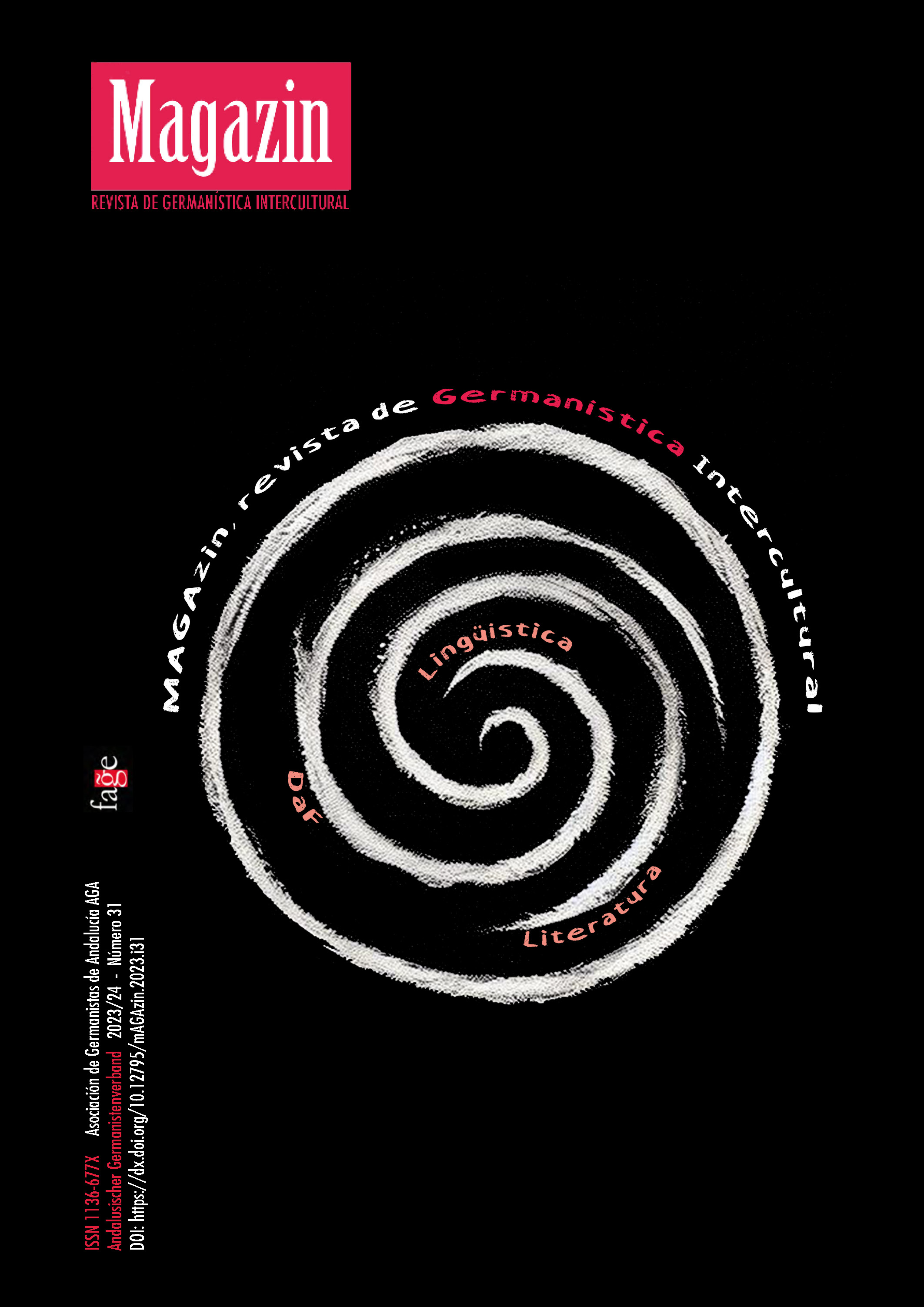Discursive reformulation and its didactic application in teaching German as a foreign language
DOI:
https://doi.org/10.12795/mAGAzin.2023.03Keywords:
transcripts, reformulation, discourse markers, DaF, communicative competence, authentic materialsAbstract
This article aims to emphasize the significance of incorporating reformulation processes into the discourse of German learners. It asserts that these linguistic elements enhance communicative competence and bolster learners' strategic and cooperative capabilities. The objective is to propose didactic reflections focused on teaching reformulation markers and their practical application in authentic spoken language through corpus analysis. German L2 teachers are encouraged to experiment with the suggested approaches.
Downloads
References
Bahlo, N., Kalkavan-Aydin, Z., y Weidner, B. (2017). „Und?“ – Sprachreflexive Übungen zur Konjunktion und im Mündlichen. Praxis Deutsch, 263, 30-33.
Centrum für Sprache und Interaktion. (2010). Reproducción. DAAD Gesprochene Sprache für die Auslandsgermanistik. Recuperado el 28 de junio de 2024, de http://audiolabor.uni-muenster.de/daf/.
Centrum für Sprache und Interaktion. (2016). Reproducción. Plattform Gesprochenes Deutsch. Authentische Alltagsinteraktion für die Forschung und Praxis im Bereich DaF und DaZ. Recuperado el 28 de junio de 2024, de https://dafdaz.sprache-interaktion.de.
Digitales Wörterbuch der Deutschen Sprache. Recuperado el 12 de octubre de 2024, de https://www.dwds.de/.
Ferrer, H., y Contreras, J. (2009). La reformulación del discurso en español en comparación con el alemán. En M. P. Garcés (Ed.), La reformulación del discurso en español en comparación con otras lenguas (pp. 181-202). Universidad Carlos III.
Fuentes, C. (1993). Conclusivos y reformulativos. Verba, 20, 171-198.
Gaulmyn, M. M. (1987). Reformulation et planification métadiscursives. En J. Cosnier & C. Kerbrat-Orecchioni (Eds.), Décrire la conversation (pp. 167-198). Presses Universitaires de Lyon.
Günthner, S., Schopf, J., y Weidner, B. (Eds.). (2021). Gesprochene Sprache in der kommunikativen Praxis – Analysen authentischer Alltagssprache und ihr Einsatz im DaF-Unterricht. Stauffenburg.
Hausendorf, H., y Kesselheim, W. (2008). Textlinguistik fürs Examen. Vandenhoeck & Ruprecht.
Imo, W., y Weidner, B. (2018). Mündliche Korpora im DaF- und DaZ-Unterricht. En T. Schmidt & M. Kupietz (Eds.), Korpuslinguistik (pp. 231-251). de Gruyter.
Instituto Cervantes (2001). Marco común europeo de referencia para las lenguas: Aprendizaje, enseñanza, evaluación. MECD-Anaya.
Kars, J., y Häussermann, U. (1988). Grundgrammatik Deutsch. Verlag Moritz Diesterweg.
Robles, F. (2012a). La reformulación en las gramáticas alemanas contemporáneas. Estudios Filológicos Alemanes, 24, 179-188.
Robles, F. (2012b). Los marcadores de reformulación alemanes: estudio preliminar. Revista de Filología Alemana, 20, 159-179.
Robles, F. (2012c). Los marcadores de reformulación alemanes: entre la conexión y la argumentación. Revista de Lingüística y Lenguas Aplicadas, 7, 213-224.
Rossari, C. (1994). Les opérations de réformulation. Peter Lang.
Schwitalla, J. (1997). Gesprochenes Deutsch: Eine Einführung (Grundlagen der Germanistik 33). Erich Schmidt Verlag.
Selting, M., et al. (2011). A System for Transcribing Talk-in-Interaction: GAT 2. Gesprächsforschung - Online-Zeitschrift zur verbalen Interaktion, 12, 1-51.
Stein, S. (1995). Formelhafte Sprache. Peter Lang.
WELT-Nachrichtensender, 2014, 22 de octubre. Angela Merkel sucht das F-Wort (IT-Gipfel 2014 Hamburg) [Video]. YouTube. https://www.youtube.com/watch?v=_qymKx6Vu7g.
Zifonun, G. (1997). Grammatik der deutschen Sprache. de Gruyter.
Downloads
Published
How to Cite
Issue
Section
License
Copyright (c) 2024 Bettina Kaminski

This work is licensed under a Creative Commons Attribution-NonCommercial-ShareAlike 4.0 International License.
Self-archiving policy
Romeo Blue Journal (applied)
Only editor PDF can be archived
Author cannot archive the pre-print version
Author cannot archive the postprint version




